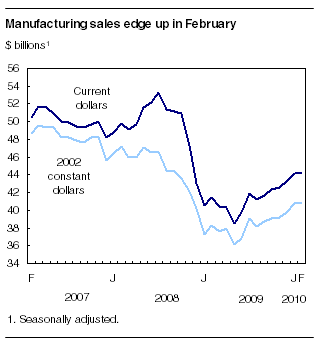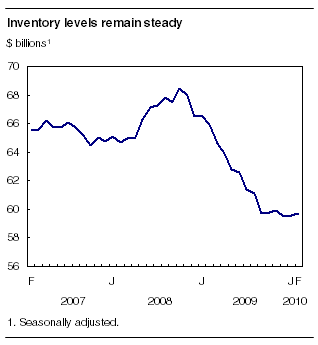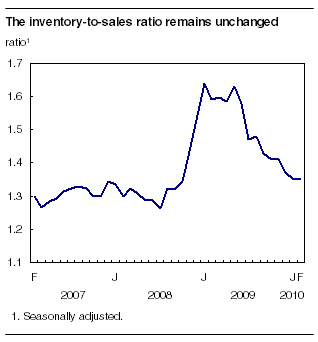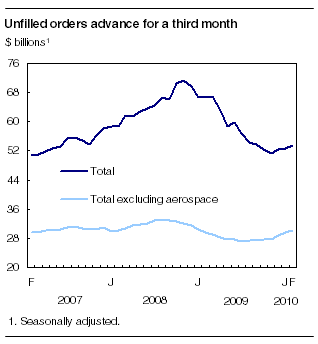Canadian manufacturing sales edged up 0.1% in February
Manufacturing sales in Canada edged up 0.1 percent in February to $44.1 billion, Statistics Canada reported on April 16. Sales have advanced in eight of the past nine months, since the recent low reached in May 2009.
Constant dollar manufacturing sales increased 0.3% in February. Constant dollar sales have increased for six consecutive months.
Sales of non-durable goods rose 0.4% in February, compared with a 0.3% drop by durable good manufacturers. Non-durable goods manufacturers have been generally out-performing the durable goods sector over the past year.
Sales gains were reported in 12 of 21 industries, representing 42.7% of total sales.

Note to readers
All data in this release are seasonally adjusted and are expressed in current dollars unless otherwise specified.
Preliminary data are provided for the current reference month. Revised data, based on late responses, are updated for the three previous months.
Non-durable goods industries include food, beverage and tobacco products, textile mills, textile product mills, clothing, leather and allied products, paper, printing and related support activities, petroleum and coal products, chemicals, and plastics and rubber products.
Durable goods industries include wood products, non-metallic mineral products, primary metals, fabricated metal products, machinery, computer and electronic products, electrical equipment, appliances and components, transportation equipment, furniture and related products and miscellaneous manufacturing.
Production-based industries
For the aerospace industry and shipbuilding industries, the value of production is used instead of sales of goods manufactured. This value is calculated by adjusting monthly sales of goods manufactured by the monthly change in inventories of goods in process and finished products manufactured.
Unfilled orders are a stock of orders that will contribute to future sales assuming that the orders are not cancelled.
New orders are those received whether sold in the current month or not. New orders are measured as the sum of sales for the current month plus the change in unfilled orders from the previous month to the current month.
Industry results mixed
Although 12 industries reported gains in February, these were largely offset by decreases in the remaining 9. Sales by plastic and rubber product manufacturers rose 4.4% during the month, following a 9.0% gain in January.
Chemical product manufacturers also reported strong gains, up 4.3% in February. Sales in this industry have increased for five consecutive months, reaching the highest level since October 2008. Much of the strength in February reflected sales gains by pharmaceutical and medical manufacturers, triggered in part by medical aid being sent to Haiti.
The petroleum and coal products industry (-3.9%) reported the largest decrease in February. Sales were pushed down by a combination of factors, including lower prices and the impact of fires at two refineries.
The transportation equipment industry declined for a second month, following sizeable gains during the latter half of 2009. Motor vehicle manufacturing sales decreased 1.1%, in part reflecting temporary shutdowns. Motor vehicle parts sales decreased 3.4% compared with January, while aerospace production declined 0.4%.
Most strength seen in Western Canada and Ontario
Provincial results were evenly split in February, with most of the sales increases in Western Canada and Ontario.
The Prairie provinces were a source of strength in February, gaining 3.3%. Alberta led the provincial gains, up 4.4%, reflecting strong increases in computers and electronics, petroleum and coal, and chemical product sales.
Sales in Ontario advanced for a third consecutive month (+0.7%), despite a 1.5% decrease in the transportation equipment industry. Tobacco and beverage manufacturing (+14.6%) and chemical products (+7.1%) were behind most of the gains.
The Atlantic provinces reported a 9.5% decrease in sales for February. Sales in Newfoundland and Labrador fell a substantial 33.8%, followed by a 7.1% drop in New Brunswick and a 4.2% decline in Nova Scotia. Only Prince Edward Island managed a gain during the month, rising 1.3%.
Sales in Quebec declined 1.0% in February, reversing half of the gain reported in January. Decreases were widely based during the month, with key industries such as food, petroleum and coal, primary metals, and transportation all reporting declines.
Inventory levels remain stable
Inventory levels remained stable in February, edging up 0.2% compared with January. Inventories have stabilized over the past five months after decreasing steadily between February and September 2009.
Petroleum and coal product manufacturers reported the largest increase in inventories, up 10.2%. Most of the increase was due to large deliveries of raw materials to refineries during the month.
Primary metal inventories fell 4.5% in February. Lower prices compared with January were behind about half of the decline.

The inventory-to-sales ratio held steady at 1.35 in February, unchanged from the previous month. The inventory-to-sales ratio has been falling since May 2009, and has returned to a level seen prior to the economic downturn.

Unfilled orders rise for third month
The backlog of unfilled orders rose for a third consecutive month, increasing 1.5% to $53.4 billion. Despite the recent gains, unfilled orders still remain well below levels reported prior to the economic downturn at the end of 2008.
Much of the advance in unfilled orders in February was centred in the machinery industry, where the backlog of orders increased by 3.5%.
Unfilled orders in the aerospace industry also moved ahead 0.4%; the second increase in the past eight months. The aerospace industry usually accounts for over 40% of unfilled orders.

New orders advanced 1.4% in February to $44.9 billion, led by gains in transportation equipment, chemical products, and computers and electronics. New orders have been on the rise since June 2009.
Available on CANSIM: tables 304-0014 to 304-0015 and 377-0008.
Definitions, data sources and methods: survey number 2101.
Data from the March Monthly Survey of Manufacturing will be released on May 14.
For more information, or to order data, contact the dissemination officer (toll-free 1-866-873-8789; 613-951-9497; fax: 613-951-3877; manufact@statcan.gc.ca). To enquire about the concepts, methods or data quality of this release, contact Elton Cryderman (613-951-4317, elton.cryderman@statcan.gc.ca), Manufacturing and Energy Division.
Table 1
| February 2009 | January 2010r | February 2010p | January to February 2010 | February 2009 to February 2010 | |
|---|---|---|---|---|---|
| Seasonally adjusted | |||||
| $ millions | % change1 | ||||
| Manufacturing sales (current dollars) | 41,426 | 44,071 | 44,098 | 0.1 | 6.4 |
| Manufacturing sales (2002 constant dollars) | 38,431 | 40,754 | 40,874 | 0.3 | 6.4 |
| Manufacturing sales excluding motor vehicles, parts and accessories (current dollars) | 37,920 | 38,705 | 38,831 | 0.3 | 2.4 |
| Inventories | 65,965 | 59,586 | 59,704 | 0.2 | -9.5 |
| Unfilled orders | 66,556 | 52,609 | 53,381 | 1.5 | -19.8 |
| Unfilled orders excluding motor vehicles, parts and accessories | 65,472 | 52,075 | 52,859 | 1.5 | -19.3 |
| New orders | 41,324 | 44,228 | 44,869 | 1.4 | 8.6 |
| New orders excluding motor vehicles, parts and accessories | 37,780 | 38,877 | 39,614 | 1.9 | 4.9 |
| Inventory-to-sales ratio | 1.59 | 1.35 | 1.35 | ... | ... |
Table 2
| Major group of industries | February 2009 | January 2010r | February 2010p | January to February 2010 | February 2009 to February 2010 |
|---|---|---|---|---|---|
| Seasonally adjusted | |||||
| $ millions | % change1 | ||||
| Food manufacturing | 6,702 | 6,891 | 6,847 | -0.6 | 2.2 |
| Beverage and tobacco product | 884 | 903 | 954 | 5.7 | 8.0 |
| Textile mills | 129 | 153 | 136 | -11.3 | 5.2 |
| Textile product mills | 145 | 163 | 168 | 3.3 | 16.0 |
| Clothing manufacturing | 230 | 177 | 201 | 13.4 | -12.3 |
| Leather and allied product | 32 | 34 | 33 | -2.7 | 4.4 |
| Wood product | 1,428 | 1,492 | 1,547 | 3.7 | 8.3 |
| Paper manufacturing | 2,187 | 2,138 | 2,208 | 3.2 | 0.9 |
| Printing and related support activities | 824 | 771 | 754 | -2.3 | -8.5 |
| Petroleum and coal product | 4,562 | 5,754 | 5,531 | -3.9 | 21.3 |
| Chemical | 3,497 | 3,760 | 3,921 | 4.3 | 12.1 |
| Plastics and rubber products | 1,581 | 1,695 | 1,770 | 4.4 | 11.9 |
| Non-metallic mineral product | 947 | 1,096 | 1,102 | 0.6 | 16.4 |
| Primary metal | 3,101 | 3,312 | 3,266 | -1.4 | 5.3 |
| Fabricated metal product | 2,585 | 2,405 | 2,440 | 1.5 | -5.6 |
| Machinery | 2,478 | 2,154 | 2,181 | 1.2 | -12.0 |
| Computer and electronic product | 1,545 | 1,396 | 1,447 | 3.6 | -6.3 |
| Electrical equipment, appliance and component | 825 | 780 | 745 | -4.5 | -9.7 |
| Transportation equipment | 5,948 | 7,232 | 7,099 | -1.8 | 19.4 |
| Motor vehicle | 2,017 | 3,702 | 3,660 | -1.1 | 81.4 |
| Motor vehicle body and trailer | 231 | 276 | 249 | -10.0 | 7.6 |
| Motor vehicle parts | 1,489 | 1,664 | 1,607 | -3.4 | 7.9 |
| Aerospace product and parts | 1,699 | 1,240 | 1,236 | -0.4 | -27.3 |
| Railroad rolling stock | 118 | 53 | 91 | 70.1 | -22.9 |
| Ship and boat building | 90 | 123 | 117 | -4.9 | 30.0 |
| Furniture and related product | 877 | 875 | 885 | 1.2 | 0.9 |
| Miscellaneous manufacturing | 921 | 890 | 862 | -3.2 | -6.4 |
| Non-durable goods industries | 20,772 | 22,440 | 22,524 | 0.4 | 8.4 |
| Durable goods industries | 20,654 | 21,630 | 21,574 | -0.3 | 4.5 |




